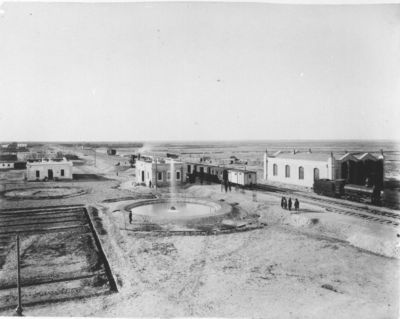Trans-Caspian railway
The Trans-Caspian railway (later called the Central Asiatic Railway) is a railway that follows the path of the Silk Road through much of western Central Asia. It was built by the Russian Empire during its expansion into Central Asia in the 19th century.
History
Construction was begun in 1879 as a narrow-gauge railway to Kyzyl-Arvat in connection with the Russian conquest of Transcaspia under General Mikhail Skobelev. It was rapidly altered to the standard Russian gauge of five feet, and construction through to Ashkabad and Merv (modern Mary) was completed under General Mikhail Annenkov in 1886. Originally the line began from Uzun-Ada on the Caspian Sea, but the terminus was later shifted north to the harbour at Krasnovodsk. The Railway reached Samarkand via Bukhara in 1888, where it halted for ten years until extended to Tashkent and Andijan in 1898. The permanent bridge over the Oxus (Amu-Darya) was not completed until 1901, and until then trains ran over a rickety wooden construction that was often damaged by floods.
Route
The railway starts at the eastern shore of the Caspian Sea at Turkmenbashi (Krasnovodsk) and heads southeast, along the edge of the Karakum Desert. For a while it runs parallel to the Qaraqum Canal. It passes through Ashgabat (Ashkhabad) and continues southeast, hugging the foothills of the Kopet Dagh mountains, and passing through Tejen. At Tejen a modern railway link branches off, heading to the Iranian border at Sarakhs, and thence to Mashhad in Iran. From Tejen the Trans-Caspian heads northeast, through Mary (Merv), where a branch line built in the 1890s leads to the Afghan border at Kushka, and the main line carries on to Turkmenabat (Chardjui). From there a branch built in the Soviet period connects northwestward to Urganch and on to Kazakhstan and Russia.
It continues through Bukhara (where a branch line built in 1910 leads to Termez and Dushanbe) and then carries on to Samarkand. At Sirdaryo, where it crosses the Syr Darya river, a branch runs east into the fertile Fergana Valley. From there the railway continues to Tashkent. There another northwest bound line runs to Kazakhstan, which branches at Arys forming the Turkestan-Siberia Railway to Novosibirsk.
References
- G.N. Curzon Russia in Central Asia (London) 1889
- М.А. Аннкенков Ахал-Техинский Оазис и пути к Индии (Санкт-Петербург) 1881

